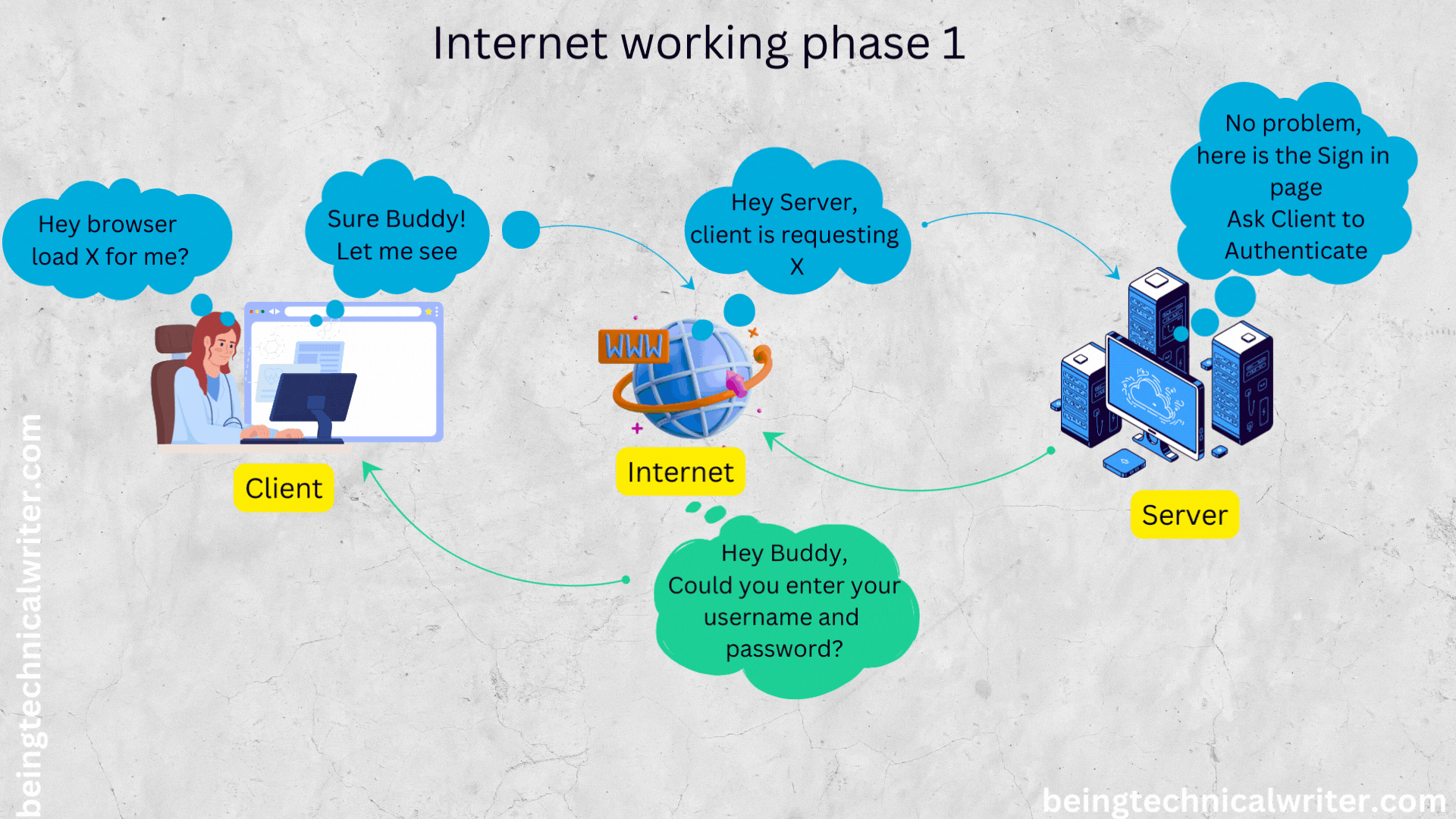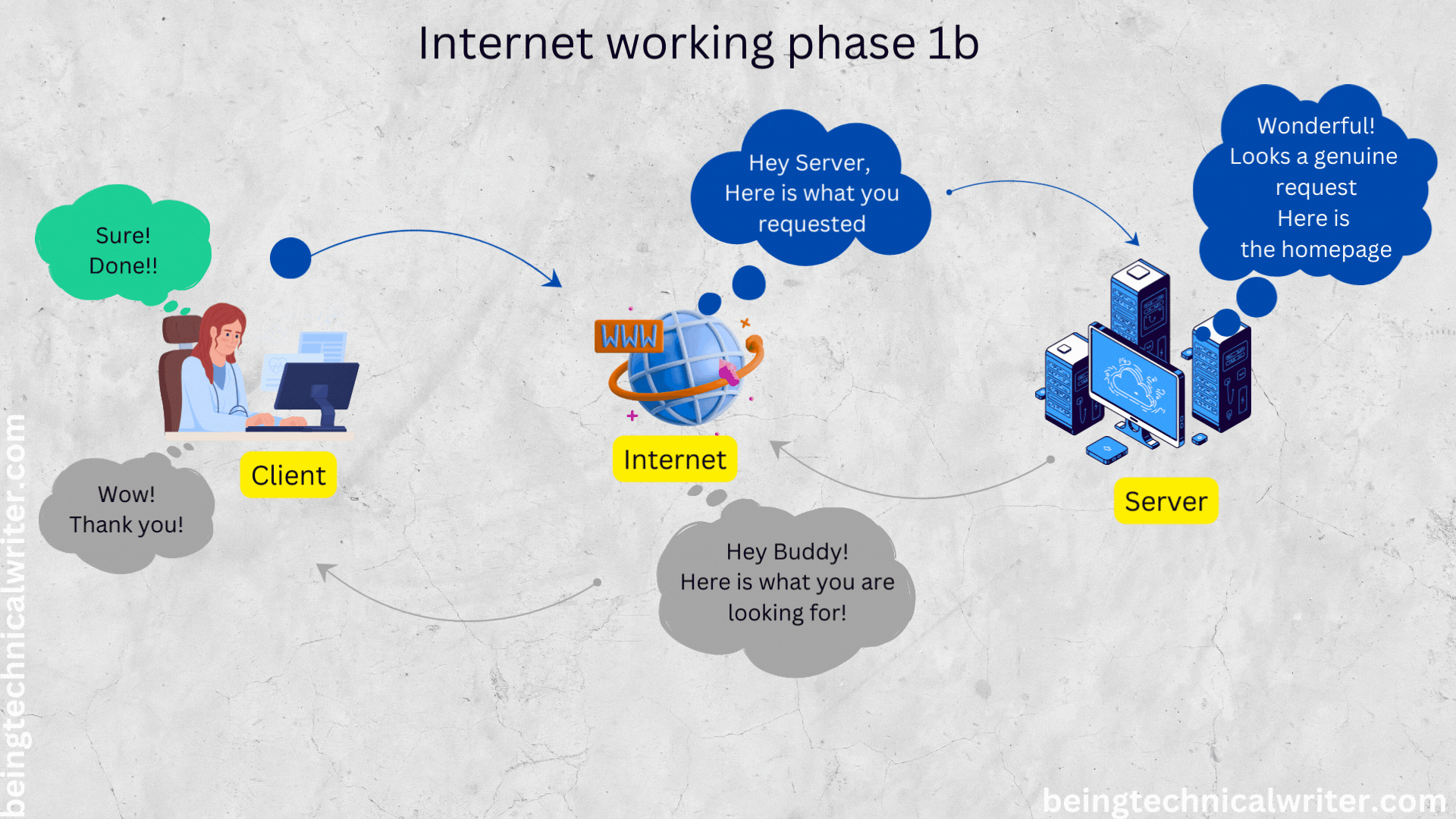How the Internet Works? Understanding Web Communication in Simple Terms
A comprehensive guide explaining how the internet works, including browsers, servers, APIs, HTTP requests, and data flow in simple, engaging language for beginners and technical writers.
Table of Contents
Welcome to the digital jungle! You’ve probably used the internet a thousand times today already (yes, including right now). But have you ever wondered how this magic actually works? I mean, how does typing “funny panda GIFs” into your browser magically bring up exactly what you want?
Think of your browser as your trusty sidekick, aiding you on a digital adventure. You’ve got questions, and the web holds the answers. But, how do they all communicate?


Step 1: Asking Nicely - Telling the Computer What You Want
Picture this: you’re sitting on your couch, craving answers (or tacos, but let’s stick with answers for now). You type something into your browser, like, “How do penguins flirt?” (Yes, they really do have moves.) Your browser nods, cracks its knuckles, and says, “Got it, boss!”
Off it goes, sprinting to a server somewhere in the world to ask, “Hey, do you have any penguin flirting tips?” It’s like your browser is that friend who always knows someone who knows someone who has what you need. The ultimate wingman.
Step 2: Proving You’re You - Authentication in Web Communication
But wait—before handing over the goods, the server might raise an eyebrow and ask, “Who are you, and how do I know you’re not a robot?” Classic server skepticism.
So, your browser turns to you and whispers, “Hey, they want proof. Give me your password.” You oblige, typing in your super-secret code (hopefully not “password123”), and voilà—the server nods approvingly. “You’re in. No robots allowed.”

Step 3: Showing Your Secret Code - Secure Data Exchange
You type in your secret code (password), and your browser hands it to the server. If it checks out, the server says, “Alright, come on in!”
Step 4: The Great Info Hunt – How Servers Process Requests
Now the server gets to work. It dives into its database, a huge digital filing cabinet, and searches for exactly what you asked for. Imagine a librarian sprinting through rows of books, muttering, “Penguins… penguins… ah, here it is!” The server grabs the info, wraps it up neatly, and sends it back to your browser. Mission accomplished.
Try it yourself: How HTTP Requests Work
Step 5: Making It Look Nice - Browser Rendering Process
When the info arrives, it’s not exactly glamorous. Think plain, unseasoned tofu. That’s where your browser’s dream team—HTML, CSS, and JavaScript—comes in. These guys are like the Queer Eye of the internet. They take that plain data and transform it into a stunning, user-friendly webpage.
Without them? Every site would look like a badly formatted Word document. Yikes.
Step 6: Magic Storage Place - Database Systems in Web Architecture
Behind the scenes, all the magic starts in the database—a giant vault of information. Imagine it as the Hogwarts library, minus the floating candles but with equally nerdy spells like SQL. Whenever the server needs something, it waves its wand (okay, it types a query), and poof—the info is retrieved. No owls required.
Step 7: Middleman Talk - API Communication Explained
Sometimes, your browser and the server need a helper to ensure everyone understands each other.
Confused?
Imagine your browser and the server are like two friends from different countries. They both want to chat and share information, but there’s a language barrier. That’s where our hero comes in – the API, short for Application Programming Interface.
Think of the API as a clever translator, fluent in both “browser language” and “server language.” Its job is to make sure your browser and the server can talk and understand each other effortlessly. It’s like the helpful friend who steps in, ensuring smooth communication between two people who speak different languages.

The API knows the rules of the game. It says, “Hey, browser, here’s how the server likes to be spoken to,” and vice versa. This way, your browser can ask for information, and the server can respond in a way that your browser can easily understand.
In simple terms, the API is the bridge that helps different parts of the web world work together. Without this translator, your browser and the server might struggle to communicate effectively, and we wouldn’t get the seamless online experience we’ve come to expect.
The Treasure Map – Understanding API Documentation
Now, APIs are amazing, but they’re not mind readers. They need instructions—like a treasure map—to know what they’re supposed to do. And that’s where you come in. API documentation is the ultimate guide for developers, showing them how to use APIs to build cool stuff without breaking anything (hopefully).
In this course, we’re going to demystify how to write this magical map. By the end, you’ll be an API documentation wizard, capable of guiding developers through the wildest API jungles. Ready to channel your inner Gandalf? Let’s go!
Frequently Asked Questions About Web Communication
Get answers to the most commonly asked questions about how the internet and web communication works.
HTTP Basics
HTTP (Hypertext Transfer Protocol) is the foundation of data communication on the web. It’s a request-response protocol where clients (browsers, apps) send requests to servers, which respond with requested resources. Each HTTP request contains a method (GET, POST, etc.), URL path, headers, and sometimes a body. Responses include a status code, headers, and usually a body containing the requested data.
HTTPS (HTTP Secure) is HTTP with encryption. While both protocols handle client-server communication, HTTPS adds a security layer using TLS/SSL to encrypt all data transferred between client and server. This encryption prevents eavesdropping, tampering, and man-in-the-middle attacks. HTTPS also verifies server identity through digital certificates and is indicated by a padlock icon in browsers.
The most common HTTP methods are: GET (retrieve data, should be idempotent), POST (submit data, create resources), PUT (update resources by replacing them entirely), PATCH (partial resource updates), DELETE (remove resources), and OPTIONS (get supported methods). GET and POST are most frequent, with GET for data retrieval and POST for data submission. RESTful APIs typically use all methods to represent different operations on resources.
Web Communication Architecture
In client-server communication, clients (browsers, mobile apps) initiate requests to servers across the internet. Servers process these requests and return appropriate responses. This stateless model works through standardized protocols like HTTP, with clients rendering the received data. The process typically involves DNS resolution to find the server, establishing a TCP connection, sending the HTTP request, receiving and processing the response, and finally rendering content.
APIs (Application Programming Interfaces) provide standardized ways for different software systems to communicate. In web communication, APIs enable clients to interact with server resources and services through defined endpoints and data formats. They abstract complex backend operations, allowing developers to access functionality without understanding implementation details. Web APIs typically use HTTP methods with JSON or XML data formats, following standards like REST or GraphQL.
When you enter a URL, the browser first extracts the domain and performs DNS lookup to get the server’s IP address. It then establishes a TCP connection with the server, potentially negotiating TLS for HTTPS. The browser sends an HTTP request to the server, which processes it and returns a response (typically HTML, CSS, JavaScript). The browser parses the HTML, fetches additional resources linked in the document, renders the page, and executes JavaScript. All this typically happens within seconds.
Web Communication Protocols
WebSocket is a communication protocol providing full-duplex communication over a single, long-lived connection. Unlike HTTP’s request-response model, WebSocket allows both client and server to send messages at any time after the initial handshake, without waiting for requests. This makes it ideal for real-time applications like chat, live updates, and gaming. WebSocket connections start as HTTP requests that upgrade to WebSocket protocol, maintaining persistent bidirectional data streams.
REST (Representational State Transfer) is an architectural style for designing networked applications. It emphasizes a stateless client-server relationship, standard operations on resources identified by URLs, and representation of resources (typically JSON or XML). REST is important because it provides a scalable, simple approach to API design that leverages existing web infrastructure and HTTP methods. RESTful systems are easy to understand and integrate with, making them the dominant paradigm for public APIs.
CORS (Cross-Origin Resource Sharing) is a security mechanism controlling how web pages in one domain access resources from another domain. It’s necessary because browsers enforce the Same-Origin Policy, restricting cross-domain requests to prevent malicious sites from accessing sensitive data. CORS works through HTTP headers: when a site makes a cross-origin request, the browser adds an Origin header, and the server must respond with Access-Control-Allow-Origin headers specifying which origins are permitted to access its resources.
Performance and Optimization
HTTP status codes are three-digit numbers in HTTP responses that indicate the request’s outcome. They’re grouped into five categories: 1xx (informational), 2xx (success), 3xx (redirection), 4xx (client errors), and 5xx (server errors). Common codes include 200 (OK), 404 (Not Found), and 500 (Internal Server Error). These codes are important because they help diagnose communication problems, automate error handling, and provide consistent status information across different services and applications.
Optimize web communication by minimizing request-response size (compression, minification), reducing the number of requests (bundling, spriting), using efficient data formats (JSON instead of XML), implementing caching strategies (browser cache, CDNs), utilizing HTTP/2 or HTTP/3 for multiplexing, employing connection pooling, optimizing DNS resolution, using asynchronous loading where appropriate, and implementing intelligent data prefetching. For APIs, consider pagination, partial responses, and optimizing query parameters.
Cookies are small pieces of data stored in the browser that websites can set and retrieve. They enhance web communication by enabling session management (keeping users logged in), personalization (remembering preferences), tracking user behavior, and maintaining state in the otherwise stateless HTTP protocol. Cookies are sent with every request to their associated domain through HTTP headers, allowing servers to recognize returning users and customize responses based on previous interactions or saved information.
Security Aspects
TLS (Transport Layer Security) and its predecessor SSL (Secure Sockets Layer) are cryptographic protocols that secure web communications. They work by authenticating the server using digital certificates, establishing a secure session with key exchange mechanisms, and encrypting all data transferred between client and server. The process involves a TLS handshake where the client and server agree on encryption algorithms and keys. This protection ensures data confidentiality, integrity, and server authenticity.
Common web communication vulnerabilities include: man-in-the-middle attacks (intercepting unencrypted traffic), cross-site scripting (XSS) injecting malicious code, cross-site request forgery (CSRF) tricking users into unwanted actions, injection attacks (SQL, command injection), insecure API endpoints, broken authentication mechanisms, sensitive data exposure through improper encryption, XML external entity attacks (XXE), using components with known vulnerabilities, and inadequate logging/monitoring that allows attacks to go undetected.
In token-based authentication, the server generates a signed token (commonly JWT) containing user identity and permissions when a user logs in. The client stores this token and includes it in the Authorization header of subsequent requests. The server validates the token’s signature and expiration before processing requests, without needing to store session data. This stateless approach scales well, works across domains, and is ideal for modern applications and microservices. Token revocation typically requires additional server-side mechanisms like blacklists.
Key Takeaways
- The internet works through a conversation between your browser (client) and servers
- Authentication ensures secure communication between browsers and servers
- Servers retrieve information from databases based on requests
- HTML, CSS, and JavaScript transform data into visually appealing webpages
- APIs act as translators between different systems, allowing them to communicate
- API documentation serves as the instruction manual for developers to use APIs effectively
Test Your Knowledge: How the Internet Works
What does a browser do when you type a URL and press Enter?
Learn More About Web Technologies
Expand your knowledge about how the internet works with these resources.



